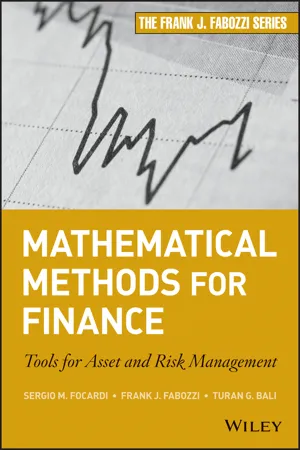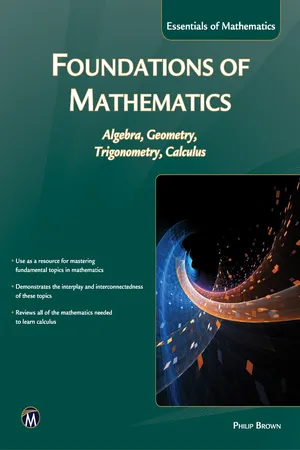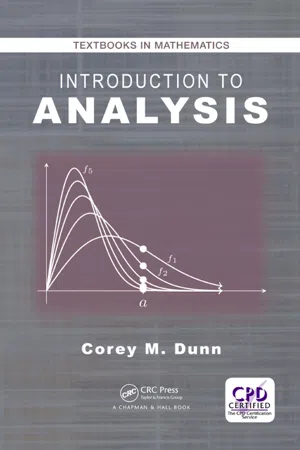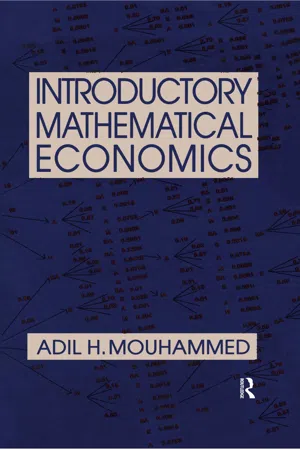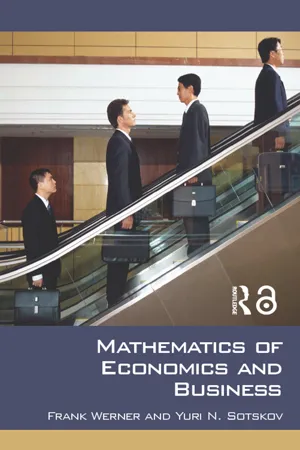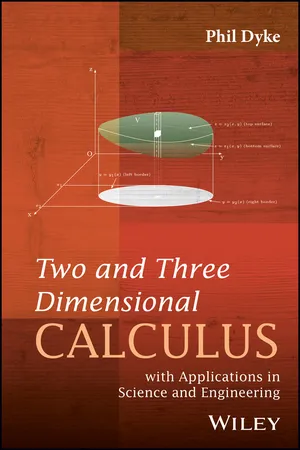Mathematics
Differentiation Rules
Differentiation rules are a set of guidelines used to find the derivative of a function. These rules include the power rule, product rule, quotient rule, and chain rule, among others. They provide a systematic approach to calculating derivatives and are fundamental in calculus for analyzing the rate of change of functions.
Written by Perlego with AI-assistance
Related key terms
Related key terms
1 of 4
Related key terms
1 of 3
7 Key excerpts on "Differentiation Rules"
- eBook - ePub
- Paul Turner, Justine Wood(Authors)
- 2023(Publication Date)
- Mercury Learning and Information(Publisher)
rules for differentiation , which can be applied across a wide range of functions of interest.The rules of differentiation provide a set of results that allow us to find the derivatives of many functions without needing to use first principles. Since the method of first principles is not always easy to apply, these rules can save us a great deal of time and effort. Therefore, we will therefore set out some of the more important rules below, along with proofs and examples where it is useful.Rule 1: Multiplication by a ConstantRule 2: Sum–Difference RuleConsider a function defined by the equation and let , where a is a real number. The derivative of y with respect to x is equal to the derivative of u with respect to x multiplied by the same constant, that isProof: This rule is easily proved using the increment theorem. Since , we have , where is infinitesimal. The derivative is therefore.EXAMPLEWe have already shown that, for , . Therefore, if we define a new function of the form it follows thatRule 3: The Product RuleLet and . If we now define a new function as the sum, or difference, of these functions, that is either or , then the derivative of this new function will be either the sum or the difference of the derivatives of the original function. That is, if then and if then The proof of this rule is obvious and is left as an exercise for the interested reader.EXAMPLEIf then by the sum–difference ruleLet and . Let then the derivative of y with respect to x is given by the following expression.The proof of this rule is a little trickier than that for the sum-difference rule and is set out explicitly below.Proof: Let be an infinitesimal change in the x variable. We haveSince and have nonzero standard parts but the standard part of is equal to zero, taking the standard part of this expression yieldswhich establishes the desired result. This is referred to as the product rule of differentiation - eBook - ePub
Mathematical Methods for Finance
Tools for Asset and Risk Management
- Sergio M. Focardi, Frank J. Fabozzi, Turan G. Bali(Authors)
- 2013(Publication Date)
- Wiley(Publisher)
- A sequence or a function tends to a finite limit if there is a number to which the sequence or the function can get arbitrarily close; a sequence or a function tends to infinity if it can exceed any given quantity. Starting from these simple concepts, rules for computing limits can be established and limits computed.
- A derivative of a function is the limit of its incremental ratio when the interval tends to zero. Derivatives represent the rate of change of quantities.
- The derivative of the product of a constant and a function is the product of the constant and the derivative of the function.
- The derivative of a sum of functions is the sum of derivatives and called termwise differentiation.
- The derivative of a product of functions is the derivative of the first function times the second plus the first function times the derivative of the second and is called the product rule.
- The derivative of a function of functions is the product of the outer function with respect to the inner function times the derivative of the inner function and is called the chain rule.
- A derivative of order n of a function is defined as the function that results from applying the operation of derivation n times.
- A function that is differentiable to any order at a given point a can be represented as a series of the powers of (x – a ) times the n- th derivative at a times the reciprocal of n! ; this expansion is called a Taylor series expansion.
- A Taylor series expansion series is used to approximate the value of a function.
- Taylor series truncated to the first or second terms are called first- and second-order approximations, respectively.
- A special case of the Taylor series is a Maclaurin series. The McLaurin series is the Taylor series computed around x = 0.
- Differentiation can be extended to functions of more than one variable.
- A function of n variables has n first derivatives, n- square second derivatives, and so on.
1. The rate of change should not be confused with the return on an asset, which is the asset’s percentage price change.2. If the short-term rate is variable:3. When interest rates are deterministic but time-dependent, the derivative dV /di is computed as follows. Assume that interest rates experience a parallel shift i (t ) + x and compute the derivative with respect to x evaluated at x = - eBook - ePub
Foundations of Mathematics
Algebra, Geometry, Trigonometry and Calculus
- Philip Brown(Author)
- 2016(Publication Date)
- Mercury Learning and Information(Publisher)
8DIFFERENTIAL CALCULUS
8.1INTRODUCTION
Differential calculus, the topic of this chapter, is, in large part, the legacy of Sir Isaac Newton. In his gigantic publication, The Principia Mathematica, Newton introduced the mathematics of calculus and applied it to the scientific study of the orbits of the planets around the sun. Thus, he not only revolutionized science but also created the mathematics he needed in order to do so.This chapter deals with the derivatives of functions. While we study a function abstractly as mathematical object, in real-world applications it is a representation of motion (in a very general sense). In differential calculus, the notion of the derivative of a function, and the corresponding geometric notion of the slope of a tangent line to the graph of the function, relates to the idea of “instantaneous motion.” As we will begin to explain, in this chapter, the knowledge gained about the “instantaneous motion” of a function enables us to investigate and discover important properties of the function; for example, where the peaks of a function occur, or the approximate behavior of a function near any particular point in the domain of the function.In this chapter we will give the definition of the derivative, introduce the notion of a derivative function and present the rules (the power rule, sum rule, product rule, quotient rule and the chain rule) for computing it, and apply the definition and rules to compute the derivatives of the standard functions (such as polynomial, rational, root, trigonometric, exponential and logarithmic, inverse trig), and vector functions.In section 8.2 , the definition of the derivative is introduced in four parts: in section 8.2.1 , the notion of a graph “leveling out” at the origin and its mathematical statement in terms of a limit is an intuitive and mathematically simplest starting point. In section 8.2.2 , the tangent line to a graph at the origin is introduced as the best approximating line by means of a graphical example. This is interpreted in section 8.2.3 , as it is stated that the difference function (graph minus tangent line) “levels out” at the origin. Consequently, the limit formula from section 8.2.1 can be applied to derive the slope of the tangent line at the origin. Finally, in section 8.2.4 - eBook - ePub
- Corey M. Dunn(Author)
- 2017(Publication Date)
- Chapman and Hall/CRC(Publisher)
6Differentiation
Chapter Summary:The derivative of a function can reveal much about its behavior. This chapter aims to introduce the derivative and to present several very important results, including the Mean Value Theorem, Taylor’s Theorem, and L’Hôpital’s Rule.Section 6.1 : The Derivative.The derivative of a function is defined, and basic results concerning differentiation are established, such as the Product, Quotient, and Chain Rules. Afterward, extrema, Rolle’s Theorem, and an intermediate value property are discussed.Section 6.2 : The Mean Value Theorem.The Mean Value Theorem is proven here, and several applications are presented.Section 6.3 : Taylor Polynomials.Taylor Polynomials are introduced and motivated. We prove Taylor’s Theorem (Theorem 6.25), and illustrate how one uses it to obtain useful approximations for functions and their values.Section 6.4 : L’Hôpital’s Rule.L’Hôpital’s Rule (Theorem 6.29) is stated and proved as it applies to theand0 0indeterminate forms. A description of applications of this to other indeterminate forms is given.∞ ∞Section 6.5 : Troubleshooting Guide for Differentiation.A list of frequently asked questions and their answers, arranged by section. Come here if you are struggling with any material from this chapter.6.1 The DerivativeThe derivative of a function is intended to be a measurement of the rate at which a function’s outputs change. Beyond this usefulness, however, the entire theory of differentiation is of interest because of its vast reach in many other fields of mathematics.We begin this subject with a definition (Definition 6.1), and go on to establish some elementary facts about the derivative which are very likely familiar from basic calculus. The discussion then turns to finding extrema of a function (Theorem 6.9), the intuitive and fundamental Rolle’s Theorem (Theorem 6.11), and an intermediate value property.6.1.1 Derivatives
The derivative is a fundamental concept in the subject of analysis. The motivation for this object is that it is to measure how a function changes at a given point. Graphically, this is seen as the slope of a secant line approaching the slope of the tangent line at a given point as shown in Figure 6.1.1. - eBook - ePub
- Adil H. Mouhammed(Author)
- 2020(Publication Date)
- Routledge(Publisher)
Chapter TwoDerivatives and Applications
Economic decisions are based on marginal analysis. For example, the monopolist’s best level of output is determined by equating marginal cost and marginal revenue. To find the marginal cost and revenue, total cost and revenue functions must be differentiated with respect to the output level. Similarly, derivatives can be used in many applications in business and economics. For this reason, the rules of differentiation are outlined in this chapter, and many applications are provided.The Concept of Derivative
The derivative of a function measures the rate of change of the dependent variable y with respect to the independent variable x--the slope of the function. That is, the derivative indicates the impact of a small change in x on y. For example, suppose the dependent variable y is the quantity supplied by a producer, and x is the price of that product. Mathematically, the function is written asy = f( x ).Now, if the price x changes by a very small amount (dx), the quantity supplied will change by a very small amount (dy) as well. These small changes, dx and dy, are called the differential of x and y, respectively. After these changes, the new magnitude of the two variables becomes (y + dy) and (x + dx). And dy/dx is called the derivative of y with respect to x. In other words, dy/dx shows the changes in y per unit change in x. The process of finding the derivative is called the differentiation process.If a given function is a univariate function, such as the above, the following rules of differentiation (Glaister 1984; Chiang 1984; Ostrosky and Koch 1986) are applied:Rule 1: Derivative of a Constant Function
If y = f(x) = k, where k is a constant, then dy/dx = 0Example 1: Differentiate y = f(x)= 30. Solution: dy/dx = 0Example 2: If the fixed cost of a product q is FC = 20, then the derivative of the fixed cost with respect to q is d(FC)/dq = 0. That is, if q changes, the fixed cost will not change. - eBook - ePub
- Frank Werner, Yuri N. Sotskov(Authors)
- 2006(Publication Date)
- Routledge(Publisher)
4 Differentiation
In economics, there are many problems which require us to take into account how a function value changes with respect to small changes of the independent variable (e.g. input, time, etc.). For example, assume that the price of some product changes slightly. The question is how does this affect the amount of product customers will buy? A useful tool for such investigations is differential calculus, which we treat in this chapter. It is an important field of mathematics with many applications, e.g. graphing functions, determination of extreme points of functions with or without additional constraints. Differential calculus allows us to investigate specific properties of functions such as monotonicity or convexity. For instance in economics, cost, revenue, profit, demand, production or utility functions have to be investigated with respect to their properties. In this chapter, we consider functions f : Df → ℝ depending on one real variable, i.e. Df ⊆ ℝ.4.1 LIMIT AND CONTINUITY
4.1.1 Limit of a function
One of the basic concepts in mathematics is that of a limit (see Definition 2.6 for a sequence). In this section, the limit of a function is introduced. This notion deals with the question of which value does the dependent variable y of a function f with y = f (x) approach as the independent variable x approaches some specific value x0 ?Definition 4.1 The real number L is called the limit of function f : Df → ℝ as x tends to x0 if for any sequence {xn } with xn ≠ x0 , xn ∈ Df , n = 1, 2, . . . , which converges to x0 , the sequence of the function values {f (xn )} converges to L.Thus, we say that function f tends to number L as x tends to (but is not equal to) x0 . As an abbreviation we writeNote that limit L must be a (finite) number, otherwise we say that the limit of function f as x tends to x0 does not exist. If this limit does not exist, we distinguish two cases. If L = ±∞, we also say that function f is definitely divergent as x tends to x0 , otherwise function f is said to be indefinitely divergent as x tends to x0 - eBook - ePub
Two and Three Dimensional Calculus
with Applications in Science and Engineering
- Phil Dyke(Author)
- 2018(Publication Date)
- Wiley(Publisher)
For notational convenience the derivative of with respect to is often written and is called the suffix derivative notation. The above pairs written this way would be: and This notation will be used increasingly from now. While on notation, sometimes it is necessary to be specific about what is being held constant when differentiating partially, so the notation is adopted to emphasise that is being held constant. Those of you that have to study thermodynamics will surely meet this. In this book it is very seldom used as it is obvious what is being held constant. 2.4.1 Leibniz Rule An application of the chain rule, Leibniz rule is sometimes called ‘differentiation under the integral sign’. Here is the rule in the form of a theorem: Theorem 2.1 If where is integrable in and differentiable in the variable, and are differentiable functions, then Proof There is a longer proof from first principles that uses the mean value theorem, this proof uses the chain rule. Assuming that where and are themselves functions of the chain rule can take the form: 2.10 where the explicit dependence of on is restricted to and does not include the dependence of and on. This means that Using the fundamental theorem of the calculus: which essentially is a statement that differentiation and integration are inverse operations, it can be stated that Inserting these results into Equation (2.10) gives the required result Here is an example of its use. Example 2.6 Given the result find Solution The integral given is by no means obvious, but can be proved by the substitution. See Exercise 1.9 at the end of the last chapter
Index pages curate the most relevant extracts from our library of academic textbooks. They’ve been created using an in-house natural language model (NLM), each adding context and meaning to key research topics.
Explore more topic indexes
Explore more topic indexes
1 of 6
Explore more topic indexes
1 of 4

